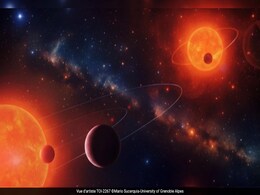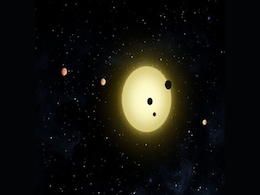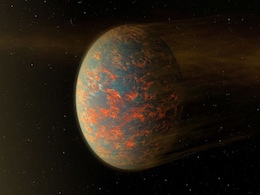Planetary Orbits
- All
- News
-

JWST Reveals Powerful Winds and Dense Atmosphere on Scorching Exoplanet TOI-561b
- Wednesday December 31, 2025
- Written by Gadgets 360 Staff
Astronomers using NASA’s James Webb Space Telescope have found compelling evidence that TOI-561b, an ultra-hot rocky exoplanet orbiting its star every 11 hours, still retains a dense atmosphere. Temperatures measured on both its day and night sides are far lower than expected for a bare rock, implying powerful winds and efficient heat transport. ...
-
 www.gadgets360.com
www.gadgets360.com
-

The Most Exciting Exoplanet Discoveries of 2025: Know the Strange Worlds Scientists Have Found
- Sunday December 28, 2025
- Written by Gadgets 360 Staff
Astronomers marked a milestone year as confirmed exoplanets surpassed 6,000 in 2025. Discoveries ranged from planets orbiting two suns to worlds losing their atmospheres or forming in real time. The findings reshaped ideas about how planets form, survive, and evolve across the Milky Way.
-
 www.gadgets360.com
www.gadgets360.com
-

New Orbital Clues Reveal How Hot Jupiters Moved Close to Their Stars
- Tuesday December 16, 2025
- Written by Gadgets 360 Staff
Researchers reveal some hot Jupiters drifted inward smoothly through protoplanetary disks, offering clues to planetary system formation and stability.
-
 www.gadgets360.com
www.gadgets360.com
-

JWST Detects Thick Atmosphere on Ultra-Hot Rocky Exoplanet TOI-561 b
- Sunday December 14, 2025
- Written by Gadgets 360 Staff
Astronomers using the James Webb Space Telescope have discovered compelling evidence of a thick atmosphere surrounding TOI-561 b, an ultra-hot rocky exoplanet orbiting its star every 11 hours. Despite extreme radiation and molten surface conditions, the planet appears cooler than expected, suggesting heat-redistributing atmospheric winds and volati...
-
 www.gadgets360.com
www.gadgets360.com
-

TRAPPIST-1e Methane Signal Likely False, Webb Data Suggests Airless Planet
- Thursday December 11, 2025
- Written by Gadgets 360 Staff
The TRAPPIST-1 planetary system, located about 39 light-years from Earth, hosts seven rocky worlds orbiting a cool red dwarf star. While several of these Earth-sized planets lie in the star’s habitable zone, new observations from the James Webb Space Telescope suggest their atmospheres may be too thin to support life. Earlier hints of methane aro...
-
 www.gadgets360.com
www.gadgets360.com
-

Mars Orbiter Tracks Interstellar Comet 3I/ATLAS With Unprecedented Precision
- Tuesday November 18, 2025
- Written by Gadgets 360 Staff
Scientists mapped the path of interstellar comet 3I/ATLAS with ten times greater accuracy using images from ESA’s Mars orbiter. The breakthrough shows how observations from different points in space can improve future planetary defense. The data, the first of its kind from another planet’s orbit, offers a powerful new tool for tracking fast-mov...
-
 www.gadgets360.com
www.gadgets360.com
-

AI-Assisted Study Finds No Evidence of Liquid Water in Mars’ Seasonal Dark Streaks
- Friday November 14, 2025
- Written by Gadgets 360 Staff
A large-scale AI analysis of more than two million Mars orbiter images shows that the planet’s dark slope streaks form through seasonal dust avalanches, not flowing briny water. The results settle a long-running debate, revealing that wind-driven dust activity shapes Mars’ surface and offering new insights into the planet’s climate past and e...
-
 www.gadgets360.com
www.gadgets360.com
-

Harvard Physicist Weighs In On Complex Jet Structure On Interstellar Object 3I/ATLAS
- Monday November 10, 2025
- Science | Edited by Srishti Singh Sisodia
Harvard astrophysicist Avi Loeb has listed some unusual behaviours displayed by the interstellar object.
-
 www.ndtv.com
www.ndtv.com
-

China’s Tianwen-1 Captures Rare Interstellar Comet From Orbit Around Mars
- Sunday November 9, 2025
- Written by Gadgets 360 Staff
China’s Tianwen-1 Mars mission achieved a new milestone by photographing interstellar comet 3I/ATLAS, the third such object ever recorded. This breakthrough highlights China’s growing strength in planetary science, deep-space imaging, and interstellar observation, offering scientists an unprecedented look at materials beyond our solar syste
-
 www.gadgets360.com
www.gadgets360.com
-

Japan’s Akatsuki Spacecraft Declared Inoperable, Marking End of Dedicated Venus Missions
- Monday November 3, 2025
- Written by Gadgets 360 Staff
Japan’s Akatsuki spacecraft, which studied Venus for nearly a decade, has been declared inoperable by JAXA. Successfully orbiting in 2015 after an initial failure, Akatsuki uncovered major insights into Venus’s swirling clouds and atmosphere. Its mission’s end leaves a gap until NASA’s VERITAS and DAVINCI+ missions take over.
-
 www.gadgets360.com
www.gadgets360.com
-

Astronomers Stunned By Three Earth-Sized Planets In Distant Unique Planetary System
- Wednesday October 29, 2025
- Science | Edited by Srishti Singh Sisodia
The study revealed that TOI-2267 has two closely bound stars orbiting each other, and the third planet transits the companion star.
-
 www.ndtv.com
www.ndtv.com
-

Exoplanets Explained: How Astronomers Find Worlds Orbiting Stars Beyond the Sun
- Monday September 8, 2025
- Written by Gadgets 360 Staff
Exoplanets are planets orbiting stars outside our solar system, hidden by stellar glare and detected indirectly. Astronomers identify them by tracking star wobbles or dips in brightness during planetary transits. NASA’s Kepler mission revealed thousands, with TESS now expanding the search. These discoveries confirm that planetary systems are abun...
-
 www.gadgets360.com
www.gadgets360.com
-

James Webb Telescope Discovers Tiny New Moon Orbiting Uranus
- Saturday August 23, 2025
- Written by Gadgets 360 Staff
A team from the Southwest Research Institute has discovered a tiny new moon orbiting Uranus using NASA’s James Webb Space Telescope. The moon, called S/2025 U1, is just 6 miles (10 kilometers) wide, too small for Voyager 2 to detect during its 1986 flyby. This discovery brings Uranus’s total known moons to 29, with S/2025 U1 orbiting 35,000 mil...
-
 www.gadgets360.com
www.gadgets360.com
-

ESA’s Mars Express Discovers Deep Valleys and Frozen Features Hinting at Mars’ Icy Past
- Thursday August 14, 2025
- Written by Gadgets 360 Staff
In July 2025, the European Space Agency’s Mars Express orbiter captured a high-resolution image of Acheron Fossae, a region marked by deep chasms and ridges on Mars’s surface. These features, created by ancient crustal stretching, split the terrain into raised horsts and sunken grabens. Valley floors reveal smooth surfaces carved by slow-moving...
-
 www.gadgets360.com
www.gadgets360.com
-

NASA Missions Uncover a Diverse Galaxy of Super-Earths, Raising New Questions About Planetary Evolution
- Thursday August 14, 2025
- Written by Gadgets 360 Staff
Super-Earths are among the most common planets in the galaxy, yet none exist in our solar system. Larger than Earth but smaller than Neptune, they range from ocean-covered worlds to scorched, atmosphere-less rocks. Some orbit within habitable zones, making them prime candidates for life. NASA’s Kepler and TESS missions, along with upcoming telesc...
-
 www.gadgets360.com
www.gadgets360.com
-

JWST Reveals Powerful Winds and Dense Atmosphere on Scorching Exoplanet TOI-561b
- Wednesday December 31, 2025
- Written by Gadgets 360 Staff
Astronomers using NASA’s James Webb Space Telescope have found compelling evidence that TOI-561b, an ultra-hot rocky exoplanet orbiting its star every 11 hours, still retains a dense atmosphere. Temperatures measured on both its day and night sides are far lower than expected for a bare rock, implying powerful winds and efficient heat transport. ...
-
 www.gadgets360.com
www.gadgets360.com
-

The Most Exciting Exoplanet Discoveries of 2025: Know the Strange Worlds Scientists Have Found
- Sunday December 28, 2025
- Written by Gadgets 360 Staff
Astronomers marked a milestone year as confirmed exoplanets surpassed 6,000 in 2025. Discoveries ranged from planets orbiting two suns to worlds losing their atmospheres or forming in real time. The findings reshaped ideas about how planets form, survive, and evolve across the Milky Way.
-
 www.gadgets360.com
www.gadgets360.com
-

New Orbital Clues Reveal How Hot Jupiters Moved Close to Their Stars
- Tuesday December 16, 2025
- Written by Gadgets 360 Staff
Researchers reveal some hot Jupiters drifted inward smoothly through protoplanetary disks, offering clues to planetary system formation and stability.
-
 www.gadgets360.com
www.gadgets360.com
-

JWST Detects Thick Atmosphere on Ultra-Hot Rocky Exoplanet TOI-561 b
- Sunday December 14, 2025
- Written by Gadgets 360 Staff
Astronomers using the James Webb Space Telescope have discovered compelling evidence of a thick atmosphere surrounding TOI-561 b, an ultra-hot rocky exoplanet orbiting its star every 11 hours. Despite extreme radiation and molten surface conditions, the planet appears cooler than expected, suggesting heat-redistributing atmospheric winds and volati...
-
 www.gadgets360.com
www.gadgets360.com
-

TRAPPIST-1e Methane Signal Likely False, Webb Data Suggests Airless Planet
- Thursday December 11, 2025
- Written by Gadgets 360 Staff
The TRAPPIST-1 planetary system, located about 39 light-years from Earth, hosts seven rocky worlds orbiting a cool red dwarf star. While several of these Earth-sized planets lie in the star’s habitable zone, new observations from the James Webb Space Telescope suggest their atmospheres may be too thin to support life. Earlier hints of methane aro...
-
 www.gadgets360.com
www.gadgets360.com
-

Mars Orbiter Tracks Interstellar Comet 3I/ATLAS With Unprecedented Precision
- Tuesday November 18, 2025
- Written by Gadgets 360 Staff
Scientists mapped the path of interstellar comet 3I/ATLAS with ten times greater accuracy using images from ESA’s Mars orbiter. The breakthrough shows how observations from different points in space can improve future planetary defense. The data, the first of its kind from another planet’s orbit, offers a powerful new tool for tracking fast-mov...
-
 www.gadgets360.com
www.gadgets360.com
-

AI-Assisted Study Finds No Evidence of Liquid Water in Mars’ Seasonal Dark Streaks
- Friday November 14, 2025
- Written by Gadgets 360 Staff
A large-scale AI analysis of more than two million Mars orbiter images shows that the planet’s dark slope streaks form through seasonal dust avalanches, not flowing briny water. The results settle a long-running debate, revealing that wind-driven dust activity shapes Mars’ surface and offering new insights into the planet’s climate past and e...
-
 www.gadgets360.com
www.gadgets360.com
-

Harvard Physicist Weighs In On Complex Jet Structure On Interstellar Object 3I/ATLAS
- Monday November 10, 2025
- Science | Edited by Srishti Singh Sisodia
Harvard astrophysicist Avi Loeb has listed some unusual behaviours displayed by the interstellar object.
-
 www.ndtv.com
www.ndtv.com
-

China’s Tianwen-1 Captures Rare Interstellar Comet From Orbit Around Mars
- Sunday November 9, 2025
- Written by Gadgets 360 Staff
China’s Tianwen-1 Mars mission achieved a new milestone by photographing interstellar comet 3I/ATLAS, the third such object ever recorded. This breakthrough highlights China’s growing strength in planetary science, deep-space imaging, and interstellar observation, offering scientists an unprecedented look at materials beyond our solar syste
-
 www.gadgets360.com
www.gadgets360.com
-

Japan’s Akatsuki Spacecraft Declared Inoperable, Marking End of Dedicated Venus Missions
- Monday November 3, 2025
- Written by Gadgets 360 Staff
Japan’s Akatsuki spacecraft, which studied Venus for nearly a decade, has been declared inoperable by JAXA. Successfully orbiting in 2015 after an initial failure, Akatsuki uncovered major insights into Venus’s swirling clouds and atmosphere. Its mission’s end leaves a gap until NASA’s VERITAS and DAVINCI+ missions take over.
-
 www.gadgets360.com
www.gadgets360.com
-

Astronomers Stunned By Three Earth-Sized Planets In Distant Unique Planetary System
- Wednesday October 29, 2025
- Science | Edited by Srishti Singh Sisodia
The study revealed that TOI-2267 has two closely bound stars orbiting each other, and the third planet transits the companion star.
-
 www.ndtv.com
www.ndtv.com
-

Exoplanets Explained: How Astronomers Find Worlds Orbiting Stars Beyond the Sun
- Monday September 8, 2025
- Written by Gadgets 360 Staff
Exoplanets are planets orbiting stars outside our solar system, hidden by stellar glare and detected indirectly. Astronomers identify them by tracking star wobbles or dips in brightness during planetary transits. NASA’s Kepler mission revealed thousands, with TESS now expanding the search. These discoveries confirm that planetary systems are abun...
-
 www.gadgets360.com
www.gadgets360.com
-

James Webb Telescope Discovers Tiny New Moon Orbiting Uranus
- Saturday August 23, 2025
- Written by Gadgets 360 Staff
A team from the Southwest Research Institute has discovered a tiny new moon orbiting Uranus using NASA’s James Webb Space Telescope. The moon, called S/2025 U1, is just 6 miles (10 kilometers) wide, too small for Voyager 2 to detect during its 1986 flyby. This discovery brings Uranus’s total known moons to 29, with S/2025 U1 orbiting 35,000 mil...
-
 www.gadgets360.com
www.gadgets360.com
-

ESA’s Mars Express Discovers Deep Valleys and Frozen Features Hinting at Mars’ Icy Past
- Thursday August 14, 2025
- Written by Gadgets 360 Staff
In July 2025, the European Space Agency’s Mars Express orbiter captured a high-resolution image of Acheron Fossae, a region marked by deep chasms and ridges on Mars’s surface. These features, created by ancient crustal stretching, split the terrain into raised horsts and sunken grabens. Valley floors reveal smooth surfaces carved by slow-moving...
-
 www.gadgets360.com
www.gadgets360.com
-

NASA Missions Uncover a Diverse Galaxy of Super-Earths, Raising New Questions About Planetary Evolution
- Thursday August 14, 2025
- Written by Gadgets 360 Staff
Super-Earths are among the most common planets in the galaxy, yet none exist in our solar system. Larger than Earth but smaller than Neptune, they range from ocean-covered worlds to scorched, atmosphere-less rocks. Some orbit within habitable zones, making them prime candidates for life. NASA’s Kepler and TESS missions, along with upcoming telesc...
-
 www.gadgets360.com
www.gadgets360.com
















